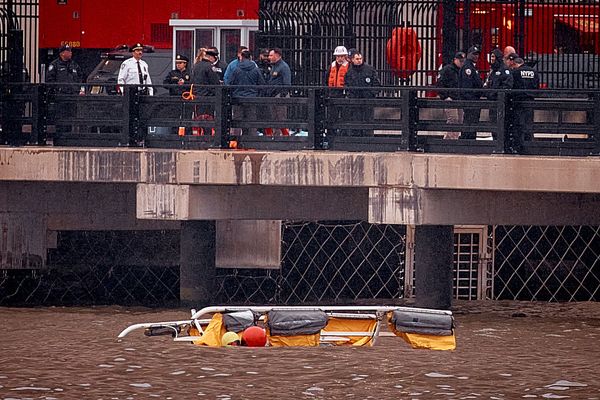
For many financial aid recipients in the California State University system, Pell grants are the ballgame. Nearly half of the system’s 460,000-plus undergraduates receive that crucial federal aid, which was created in the 1960s and finally rolled out in 1972 to help low-income students and their families afford the cost of college.
But the Trump administration’s open assault on the U.S. Department of Education and the gutting of its workforce have thrown the process of applying for federal aid into short-term chaos, CSU officials say, and Trump’s immigration threats are creating further trepidation for those with mixed-family immigration status.
The result? Almost exactly as Trump might have drawn it up: Absolute uncertainty about whether federal aid for college will be delivered as it has been in the past — with, for the time being, no clear path toward getting answers.
“It remains ambiguous what the long-term prospect will be,” Nathan Evans, CSU’s chief academic officer, said during a meeting of the system’s board of trustees in late March.
For college and university systems across the country, that ambiguity is going to affect who winds up applying for college and whether they can afford to enroll. In California, the stakes feel even higher — because the difference between struggling and thriving in the Golden State is so closely correlated with having a college degree.
It was at the March meeting that CSU trustees openly discussed a problem hiding in plain sight. With Trump’s administration slashing in half the Education Department’s workforce, that agency’s ability to fulfill one of its core missions — handling $120 billion in annual student aid — was suddenly in doubt.
At one point, the White House asserted that the department would continue to manage federal student loans and grants, but Trump’s executive order says the opposite: “The Department of Education is not a bank, and it must return bank functions to an entity equipped to serve America’s students.” The order didn’t specify who or what that entity might be. (Trump also cannot unilaterally shutter the department; that power rests with Congress.)
All of the aid still exists, including Pell grants, direct loans and work-study programs. CSU’s Evans told Capital & Main that applications for college student aid in California are actually running slightly ahead of the last two years, as tracked through FAFSA (the Free Application for Federal Student Aid) and the California Dream Act application for undocumented students.
Getting through the federal aid process, though, is another matter. State university officials say they’ve received reports from students and families who can’t get their FAFSA questions answered by anyone in the Department of Education — a not wholly unforeseen result of Trump cutting the workforce.
“We are concerned about the process it will take to really go through the FAFSA,” CSU Chancellor Mildred Garcia told the trustees. “We don’t know who’s going to be processing our FAFSA applications, who are the people in charge, et cetera.”
Added Evans, “We know that students and families reaching out for support in the process are having difficulty in connecting and engaging with folks at the federal level… [and] sometimes those answers can only come from the folks that are helping support that directly.”
It’s early days, of course, and student aid for the current spring term has already been delivered. But any disruption to the Pell Grant program in particular could be catastrophic for college students in California. The 23-school CSU system received about $2.3 billion in federal student aid for the 2022-23 academic year, most of it in Pell grants and loans. The higher-tuitioned University of California’s 10 campuses received $1.7 billion.
Pell grants don’t have to be repaid. They max out at a little less than $7,400 per student for an academic year, and are set aside specifically for low-income students and families trying to swing a college education on a tight budget. (CSU tuition for this academic year is $6,450, while fees vary by campus but can add another $2,000 or more.)
The federal funding for those grants isn’t fully guaranteed, though. Part of Pell’s budget comes from mandatory funding sources, but the rest is appropriated by Congress on a yearly basis. A Congressional Budget Office prediction of a $2.7 billion deficit in the program for 2025 has raised concerns that students might receive less in Pell money or be subject to tighter eligibility restrictions beginning in the fall — but they can’t get concrete answers to either question.
There are also immigration-based fears among students applying for aid from mixed-status families — that is, households where the college applicant is a U.S. citizen or legal permanent resident, but has a parent or spouse who is undocumented.
Trump’s calls to identify and deport undocumented residents has rattled that community, said Jose Aguilar, executive director of the financial aid office at the University of California, Riverside. Although UC Riverside has not tracked the numbers yet, Aguilar said, “It is my understanding that current immigration threats may be affecting [mixed-status family] FAFSA submissions.” Overall, the university is seeing an increase in FAFSA applications.
While all of this matters in every state, the ability to get students into and graduated from college is acutely important in California, where the income inequality gap remains one of the worst in the nation.
Education sits squarely in the middle of the gap. According to an analysis by the Public Policy Institute of California (PPIC), the state’s strong tilt toward jobs in technology and international trade (among others) have made it even more imperative that a person acquire a college degree in order to compete for the state’s better-paying occupations.
Since 1980, California households in which even one person has a four-year degree have seen their median income increase by 40%. Among households without a degree, median income over that same span has gone down by 9%.
The PPIC said that while the gap has decreased slightly over the past several years, it’s still stark: For every $1 earned by a household with no college graduates, those with at least one degree-holder earned $2.36.
The college systems in California have moved millions of students along the road to degrees. But affordability remains key — and if Trump’s decimation of the Department of Education continues to make it impossible for students to know whether they’ll receive the federal aid they need or how much, the state’s systems are going to take a hit.
“If you’re a low-income applicant, you’re not coming to a CSU unless you know that you’ve got a Pell Grant,” trustee Jack McGrory said at CSU’s March board meeting. As of now, getting that question answered is a distant hope.
Copyright 2025 Capital & Main







